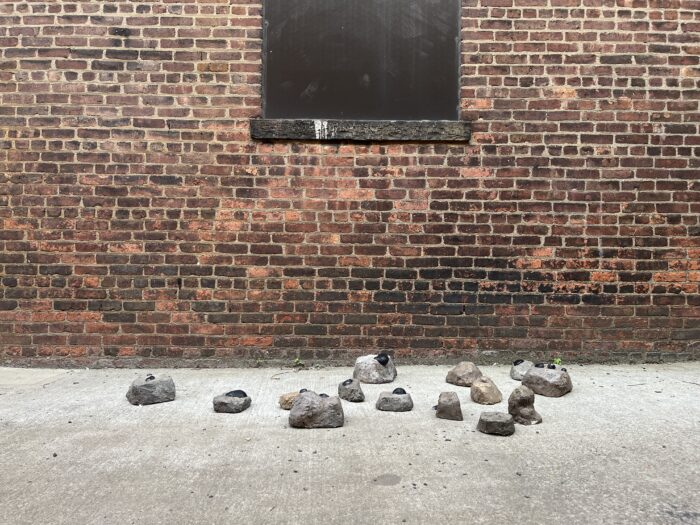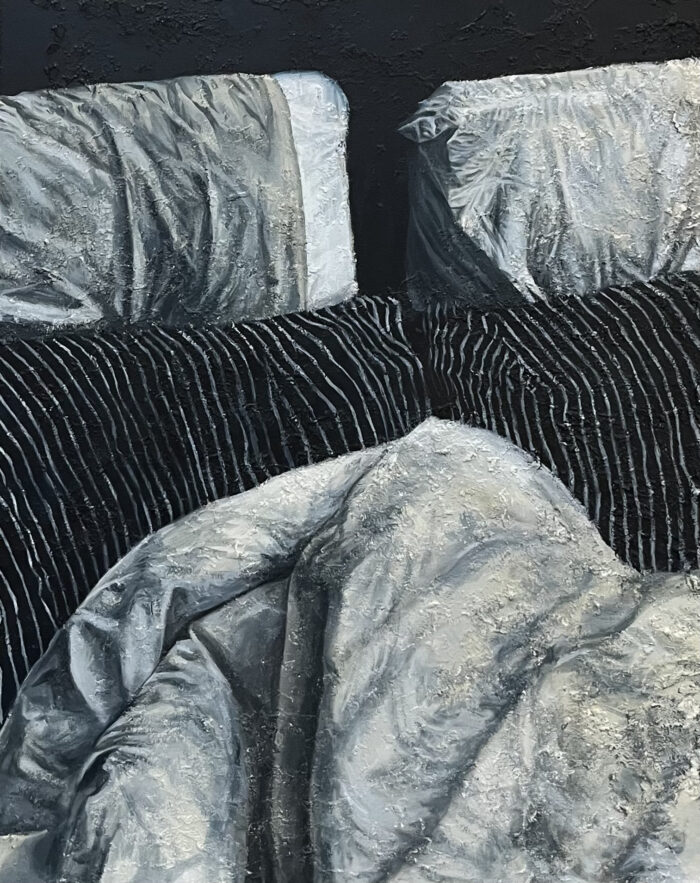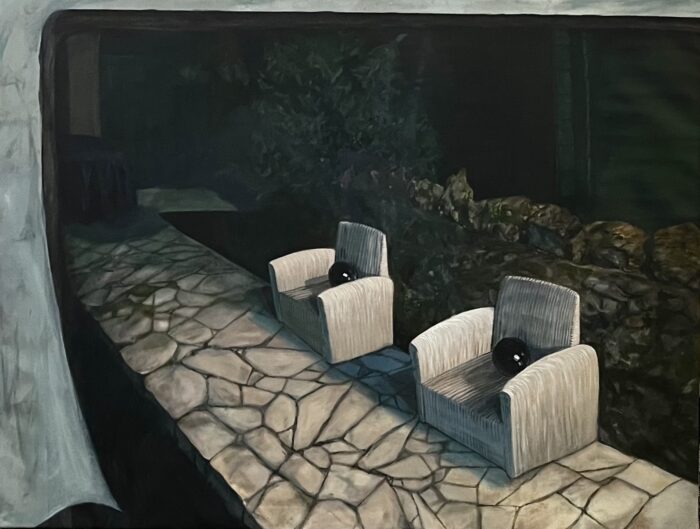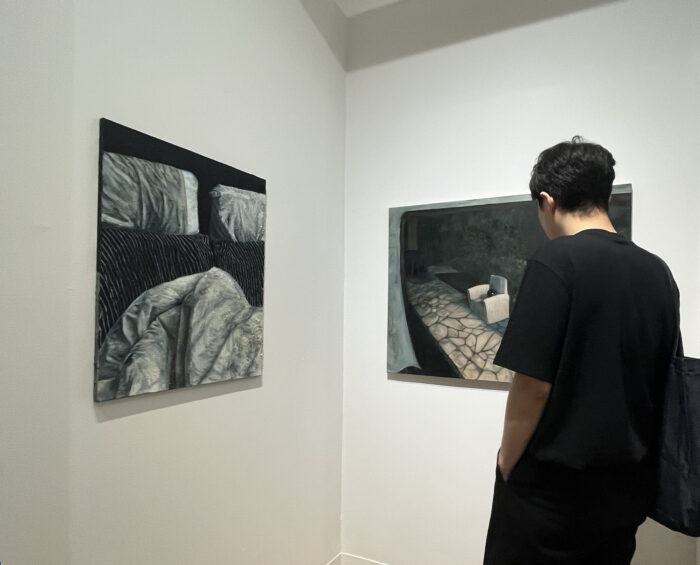Se Young Yim has been working on paintings and sculptures with non-traditional materials such as cement and wax. Her works always arouse strange feelings with haptic touch. Yim physically manipulates or realistically depicts the features of materials to induce the viewer to feel the sensations that come from texture. I visited two of her recent exhibitions, saw her work in person, and interviewed her.
Her latest sculptural piece, “Turtle(Tortoise) or Rock, 2023,” was exhibited in the show “A Labor Party,” curated by Ellen Carpenter and Flora Wilds at Trestle Artspace, Brooklyn. With themes of ‘Labor’ including the meaning of ritual and routine, private to public, the transformation of mundane objects, and the potential for “life,” Yim activated her sculpture using DC motors and made a cluster of moving sculptures on the ground.


WC: I heard that the show “A Labor Party” focuses on the performance approaches of artists from other mediums. I’d like to hear more about how ‘Labor’ and ‘Performance’ are related to your work.
SY: It was my first time making moving sculptures in my work. About 15 objects resembling rocks could be usually seen from a street, but they could move on by themselves and seemed to be alive. They rotated slowly, drew their trajectories, drifted apart, and came closer again, clashing.
When I heard about the theme of ‘Labor’ and ‘performance’, I thought of the flow of people’s movement in daily life. I was born and raised in a mega city, Seoul, South Korea, and I moved to New York and have been living the city life ever since. It’s easy to see many people when I walk in the street. They are passing by, moving in different directions and at their speeds. Some are fast, and others are slow. Each one has its way, but we can see a tremendous simple flow of movement from a distance. Just come and go. I interpreted labor as an action that is in direct contact with our life and metaphorically expressed people’s everyday movement through the performance of the sculptures.
WC: You mentioned your observation of city life, and I know you had experiences staying in various cities and countries. Your works have been exhibited internationally, such as in Seoul, London, New York, and Philadelphia. Have these experiences influenced your art practice?
SY: Sure, My experiences of temporarily living in different places have led me to think about the body’s vulnerability, which is central to my work. As I boarded the airplane, passing far distances I couldn’t see with my own eyes, I realized myself pondering the idea of “movement of the body.” From birth, I need at least a minimum amount of space to stand on my feet. Then to move another step, I need the next place to put my body physically. I don’t know anyone who hasn’t moved a single step since they were born. People move through a constant stream of temporary spaces in their life. For me, the fact that the body inevitably demands a space is interpreted as vulnerability.
WC: Could you tell me more about the ‘vulnerable physicality’ concept and how it is essential in your work?
SY: As my environment changed, I realized it wasn’t just a geographical change but a relationship change. It felt like my body constantly needed space, not just physically, but space from people. I used to use online messengers to talk to my family in Korea, and even in the virtual world, we would say we were in a ‘chat room.’ Both psychologically and physically, space seemed to be a requirement of the body, and I was often overwhelmed by this fact. While I was in the MFA program, I was mostly making sculptures, and the idea of needing storage to keep these objects was also a burden because I felt like I was projecting myself onto the work, so at the time, I was using sugar or candles as materials so that the sculpture would eventually disappear. Then, it was rather freeing to think that the body’s materiality could disappear, and the pressure on the space disappeared.
So the concept of the body was very conceptual, and I wanted to turn it into a solid object to imply movement and being in place. At that point, I was naturally interested in rocks with a history of activities, but I didn’t know where they came from and seemed to stay in the same place. I started using industrial materials such as concrete that could mimic rock’s texture.



WC: Then, let’s move on to the texture of materiality. I visited the VillageOneArt gallery in Manhattan last week and saw your paintings there. In your paintings, I could feel the surface you mentioned above. In “11:11”, you directly applied concrete on the canvas, and in the other images, I could also feel the texture in a realistic depiction; some were fragile and soft. What was your intention in these textures?
SY: I wanted to use the contrast of the textures to simultaneously convey a sense of intimacy and strangeness.
WC: For example, two of your paintings show scenes in bed, and the softness of the bedding makes them seem intimate and comfortable, while the strong contrast of the navy blue negative or black hairs makes them seem ominous. In the other one, ‘Dance with our eyes closed’, the couch looks comfortable but rough, and the sleek black spheres above it look like it could be scratched. Your paintings create an ambivalent atmosphere that is both uncomfortable and intimate. I’m curious as to why you focus on this type of language.
SY: My most significant interest is people, I have been curious about human beings, and there are so many things I don’t understand. The characteristic of things around people is that they don’t have a single personality. Life is full of coincidences and abstractions, many of which are hard to describe in words. For instance, things that are very beautiful but a little scary or things that you think are bad but are lucky. I wanted to capture and convey this subtleness in art, so I fused two opposite personalities into one image. In addition, Intimacy is the area where I struggle the most with such subtleties. There is something more connected with the body’s vulnerability, as mentioned earlier, and I keep exploring through my art practice in that way.

Through her art, Se Young creates a space for her audience to reflect on the complexities of love and the fleeting nature of connections between people and place. Her work invites viewers to engage with their emotions and memories.
Writer Woosik Choi: He is a visual artist, illustrator, art educator, and writer based in New York City. He earned a Master’s in Fine Arts from the School of Visual Arts and independently published an illustration book, “ The Constellation,” in 2023. His artwork is featured in Suboart magazine, and he has exhibited his drawings at the New Collectors Gallery, Main Street Arts, Starata Artat, and LIC-A in the USA. He was selected for “Honorable Mention” by Main Street Arts.
Artist Se Young Yim: Se Young Yim (Instagram @surrealmantis) is a New York-based painter and sculptor. She was born and raised in Seoul, South Korea, and studied Fashion there. Then she moved to the USA and received an MFA from the School of Visual Arts in New York. Also, she has worked in various countries as an international artist. She was selected by GlogauAIR in Berlin, Germany, and had a solo showcase.
Additionally, her works were exhibited at CICA Museum, Wess in South Korea, and The Holy Art in the United Kingdom, Subtitled.NYC, The Visionary Projects, Trestle Artspace, New Collectors gallery, Blah Blah gallery in the USA. Contemporary Art Collectors, Glogau AIR, and AI-Tiba9, feature her artist interviews.
